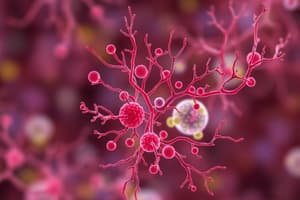Podcast
Questions and Answers
Normal flora are microorganisms that are frequently found in the skin, ______ membrane, and other body sites.
Normal flora are microorganisms that are frequently found in the skin, ______ membrane, and other body sites.
mucus
We discussed the types of the normal flora, their functions, the ______, and positives of normal flora.
We discussed the types of the normal flora, their functions, the ______, and positives of normal flora.
negatives
Normal flora can have both ______ and negative impacts on the host.
Normal flora can have both ______ and negative impacts on the host.
positive
In this assignment we talked about the elements of the normal ______.
In this assignment we talked about the elements of the normal ______.
Normal flora are microorganisms that are frequently found in various body sites such as the ______.
Normal flora are microorganisms that are frequently found in various body sites such as the ______.
One of the positive effects of normal flora is ______ against pathogens.
One of the positive effects of normal flora is ______ against pathogens.
Normal flora supports ______ by aiding in the digestion of food.
Normal flora supports ______ by aiding in the digestion of food.
A negative effect of normal flora can be ______ infections.
A negative effect of normal flora can be ______ infections.
Imbalances in normal flora can lead to ______.
Imbalances in normal flora can lead to ______.
Normal flora contributes to the ______ system development.
Normal flora contributes to the ______ system development.
The ______ causes bloodstream infections if the skin is penetrated.
The ______ causes bloodstream infections if the skin is penetrated.
The external surface of the ______ is cleaned and protected by tears, mucus, and oil.
The external surface of the ______ is cleaned and protected by tears, mucus, and oil.
The conjunctiva of the eye has primarily Staphylococcus, Streptococcus, and ______.
The conjunctiva of the eye has primarily Staphylococcus, Streptococcus, and ______.
The ______ covers the white parts of the eye and lines the inside of the eyelids.
The ______ covers the white parts of the eye and lines the inside of the eyelids.
The ______ ear and the inner ear are usually sterile.
The ______ ear and the inner ear are usually sterile.
The outer ear and the auditory canal contain the same normal flora as the moist areas like the ______ and mouth.
The outer ear and the auditory canal contain the same normal flora as the moist areas like the ______ and mouth.
______ are microorganisms that have a natural relationship with the host.
______ are microorganisms that have a natural relationship with the host.
______ normal flora consist of non pathogenic organisms that inhabit the skin or mucus membrane for hours or days.
______ normal flora consist of non pathogenic organisms that inhabit the skin or mucus membrane for hours or days.
______ consist of relatively fixed types of microorganisms regularly found in a given area.
______ consist of relatively fixed types of microorganisms regularly found in a given area.
The carrier state consists of potentially pathogenic organisms such as ______ and Neisseria meningitides.
The carrier state consists of potentially pathogenic organisms such as ______ and Neisseria meningitides.
______ flora are temporarily living on and within humans.
______ flora are temporarily living on and within humans.
Microorganisms are microscopic organisms that include bacteria, fungi, viruses, protozoa, and other small ______.
Microorganisms are microscopic organisms that include bacteria, fungi, viruses, protozoa, and other small ______.
Commensalism is a type of symbolic relationship between two organisms where one organism benefits and the other organism is neither harmed nor ______.
Commensalism is a type of symbolic relationship between two organisms where one organism benefits and the other organism is neither harmed nor ______.
Symbiosis is a relationship between two different species that live together in close ______.
Symbiosis is a relationship between two different species that live together in close ______.
Colonization refers to the establishment and growth of microorganisms in a particular area of the body without causing ______.
Colonization refers to the establishment and growth of microorganisms in a particular area of the body without causing ______.
Opportunistic pathogen are microorganisms that are normally present in or on the human body without causing harm but can cause infections or diseases when given the ______.
Opportunistic pathogen are microorganisms that are normally present in or on the human body without causing harm but can cause infections or diseases when given the ______.
Dysbiosis refers to an imbalance or disruption in the composition and functioning of the microbial communities (______) that naturally reside in and on the human body.
Dysbiosis refers to an imbalance or disruption in the composition and functioning of the microbial communities (______) that naturally reside in and on the human body.
Normal flora are microorganisms (bacterial fungi protozoa and viruses) mostly ______ that are continuously inhabited in the human body.
Normal flora are microorganisms (bacterial fungi protozoa and viruses) mostly ______ that are continuously inhabited in the human body.
Normal flora are mostly harmless and may even be ______ under normal conditions in a healthy human.
Normal flora are mostly harmless and may even be ______ under normal conditions in a healthy human.
Normal flora are mostly inhabiting the human body as ______ normal flora.
Normal flora are mostly inhabiting the human body as ______ normal flora.
Normal flora are microorganisms that are continuously inhabited in the human body in a ______ human.
Normal flora are microorganisms that are continuously inhabited in the human body in a ______ human.
Normal flora are microorganisms that are found in the ______, nose and mouth.
Normal flora are microorganisms that are found in the ______, nose and mouth.
Respiratory tract: the respiratory tract including the ______, throat, and lungs also contains a diverse group of microorganisms.
Respiratory tract: the respiratory tract including the ______, throat, and lungs also contains a diverse group of microorganisms.
Gastrointestinal tract: the largest and most diverse population of normal flora resides in the gastrointestinal GI tract, particularly in the ______.
Gastrointestinal tract: the largest and most diverse population of normal flora resides in the gastrointestinal GI tract, particularly in the ______.
Genitourinary tract: the urinary and reproductive systems also have their own microbial communities. The ______ in particular hosts a complex ecosystem of bacteria, collectively known as the vaginal microbiota.
Genitourinary tract: the urinary and reproductive systems also have their own microbial communities. The ______ in particular hosts a complex ecosystem of bacteria, collectively known as the vaginal microbiota.
The largest and most diverse population of normal flora resides in the gastrointestinal GI tract, particularly in the ______.
The largest and most diverse population of normal flora resides in the gastrointestinal GI tract, particularly in the ______.
The respiratory tract, including the ______, throat and lungs, also contains a diverse group of microorganisms.
The respiratory tract, including the ______, throat and lungs, also contains a diverse group of microorganisms.
The growth of normal flora, also known as ______ or indigenous microorganisms, is influenced by various factors.
The growth of normal flora, also known as ______ or indigenous microorganisms, is influenced by various factors.
Antibiotics can disrupt the balance of microbial populations by killing both harmful and beneficial bacteria, leading to a condition called ______.
Antibiotics can disrupt the balance of microbial populations by killing both harmful and beneficial bacteria, leading to a condition called ______.
Diet plan is a crucial role in shaping the composition of the normal flora. Certain dietary components, such as dietary fiber, prebiotics, and probiotics, can support the growth of ______ bacteria.
Diet plan is a crucial role in shaping the composition of the normal flora. Certain dietary components, such as dietary fiber, prebiotics, and probiotics, can support the growth of ______ bacteria.
Psychological and physical ______ can impact the growth of normal flora.
Psychological and physical ______ can impact the growth of normal flora.
Hygiene practices, such as hand washing and the use of ______ products, can affect the growth of normal flora.
Hygiene practices, such as hand washing and the use of ______ products, can affect the growth of normal flora.
The gut ______ of infants undergoes significant changes during the early years of life.
The gut ______ of infants undergoes significant changes during the early years of life.
The composition and diversity of the normal flora can also change with ______, which may be influenced by factors such as diet, immune function, and medication use.
The composition and diversity of the normal flora can also change with ______, which may be influenced by factors such as diet, immune function, and medication use.
While hygiene practices are important for preventing the spread of ______, they can also affect the growth of normal flora.
While hygiene practices are important for preventing the spread of ______, they can also affect the growth of normal flora.
Flashcards are hidden until you start studying
Study Notes
Normal Flora
- Normal flora refers to microorganisms that are frequently found in the skin, mucous membranes, and other body sites.
- They are harmless and may even be beneficial to the human body.
Body Sites and Their Normal Flora
- Skin: Normal flora can cause bloodstream infections if the skin is penetrated.
- Eyes: Tears contain Lysozyme enzyme, which reduces the number of normal flora of the eye.
- Conjunctiva of the eye: Primarily consists of Staphylococcus, Streptococcus, and Corynebacterium.
- Ear: The middle ear and inner ear are usually sterile, while the outer ear and auditory canal contain the same normal flora as the moist areas like the nose and mouth.
- Teeth: Poor dental hygiene helps bacteria to grow and cause dental caries and gingivitis.
Positive Effects of Normal Flora
- Protection against pathogens
- Nutrient synthesis
- Digestive support
- Immune system development
- Maintaining a healthy balance
Negative Effects of Normal Flora
- Opportunistic infections
- Imbalances leading to dysbiosis
- Allergic reactions
- Disease association
Definition of Terms
- Microorganisms: Microscopic organisms that include bacteria, fungi, viruses, protozoa, and other small life forms.
- Commensalism: A type of symbolic relationship between two organisms where one organism benefits, and the other organism is neither harmed nor benefited.
- Symbiosis: A relationship between two different species that live together in close association.
- Colonization: The establishment and growth of microorganisms in a particular area of the body without causing disease.
- Opportunistic pathogen: Microorganisms that are normally present in or on the human body without causing harm but can cause infections or diseases when given the opportunity.
- Dysbiosis: An imbalance or disruption in the composition and functioning of the microbial communities that naturally reside in and on the human body.
Types Of Normal Flora
- Commensals: Microorganisms that have a natural relationship with the host.
- Transients: Non-pathogenic organisms that inhabit the skin or mucus membrane for hours or days.
- Residents: Relatively fixed types of microorganisms that are regularly found in a given area at invariable periods if disturbed.
- Carrier state: Potentially pathogenic, for example, streptococcus pneumonia and Neisseria meningitides in the throat of a healthy individual.
Factors Affecting the Growth of Normal Flora
- Antibiotics: Can disrupt the balance of microbial populations by killing both harmful and beneficial bacteria, leading to dysbiosis.
- Diet: Certain dietary components, such as dietary fiber, prebiotics, and probiotics, can support the growth of beneficial bacteria.
- Stress: Can alter the gut environment, affecting the composition and function of the microbial community.
- Hygiene practices: Can affect the growth of normal flora by killing beneficial bacteria.
- Age: The growth of normal flora can vary across different stages of life, influenced by factors such as diet, immune function, and medication use.
Studying That Suits You
Use AI to generate personalized quizzes and flashcards to suit your learning preferences.




